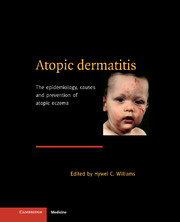Book contents
- Frontmatter
- Contents
- List of contributors
- Foreword Georg Rajka
- Preface
- Part I The nature of the problem
- 1 What is atopic dermatitis and how should it be defined in epidemiological studies?
- 2 The pathophysiology and clinical features of atopic dermatitis
- 3 The natural history of atopic dermatitis
- 4 Occupational aspects of atopic dermatitis
- Part II Descriptive studies which indicate the size of the problem
- Part III Analytical studies which point to causes of atopic dermatitis
- Part IV Intervention studies
- Part V Lessons from other fields of research
- Part VI Conclusions
- Additional information
- Index
- Plate section
3 - The natural history of atopic dermatitis
from Part I - The nature of the problem
Published online by Cambridge University Press: 17 August 2009
- Frontmatter
- Contents
- List of contributors
- Foreword Georg Rajka
- Preface
- Part I The nature of the problem
- 1 What is atopic dermatitis and how should it be defined in epidemiological studies?
- 2 The pathophysiology and clinical features of atopic dermatitis
- 3 The natural history of atopic dermatitis
- 4 Occupational aspects of atopic dermatitis
- Part II Descriptive studies which indicate the size of the problem
- Part III Analytical studies which point to causes of atopic dermatitis
- Part IV Intervention studies
- Part V Lessons from other fields of research
- Part VI Conclusions
- Additional information
- Index
- Plate section
Summary
Introduction
In a chapter such as this, it is tempting to simply repeat the same list of studies on the natural history of atopic dermatitis (AD) which have been quoted in other texts with little reservation. This would lead to a perpetuation of many of the myths surrounding this area. Instead, we will focus on highlighting the potentially serious flaws in previous studies which have examined the natural history of AD, and draw attention to major gaps in our current knowledge in order for future researchers to move forward in this important area. Before we do this, we should remind ourselves why studying the natural history of AD is important.
First, in the absence of any treatments which influence the natural history of AD, knowledge of disease prognosis is an important item of clinical information for AD sufferers and their families. As two physicians with an interest in AD, parents of children with AD invariably ask us‘will my child growout of it?’ Some ask more probing questions such as ‘when will my child grow out of it?’ or ‘why did my boy grow out of his eczema when he was aged 5, yet his sister continues to have it at the age of 10?’ or ‘willmy child go on to develop asthma?’ These are difficult questions to answer, and explaining prognosis in probabilistic terms to parents requires knowledge (which is scanty), special terms which convey the language of risk to the public (whichwe are generally poor at), and time (which is often in short supply).
- Type
- Chapter
- Information
- Atopic DermatitisThe Epidemiology, Causes and Prevention of Atopic Eczema, pp. 41 - 59Publisher: Cambridge University PressPrint publication year: 2000
- 47
- Cited by



